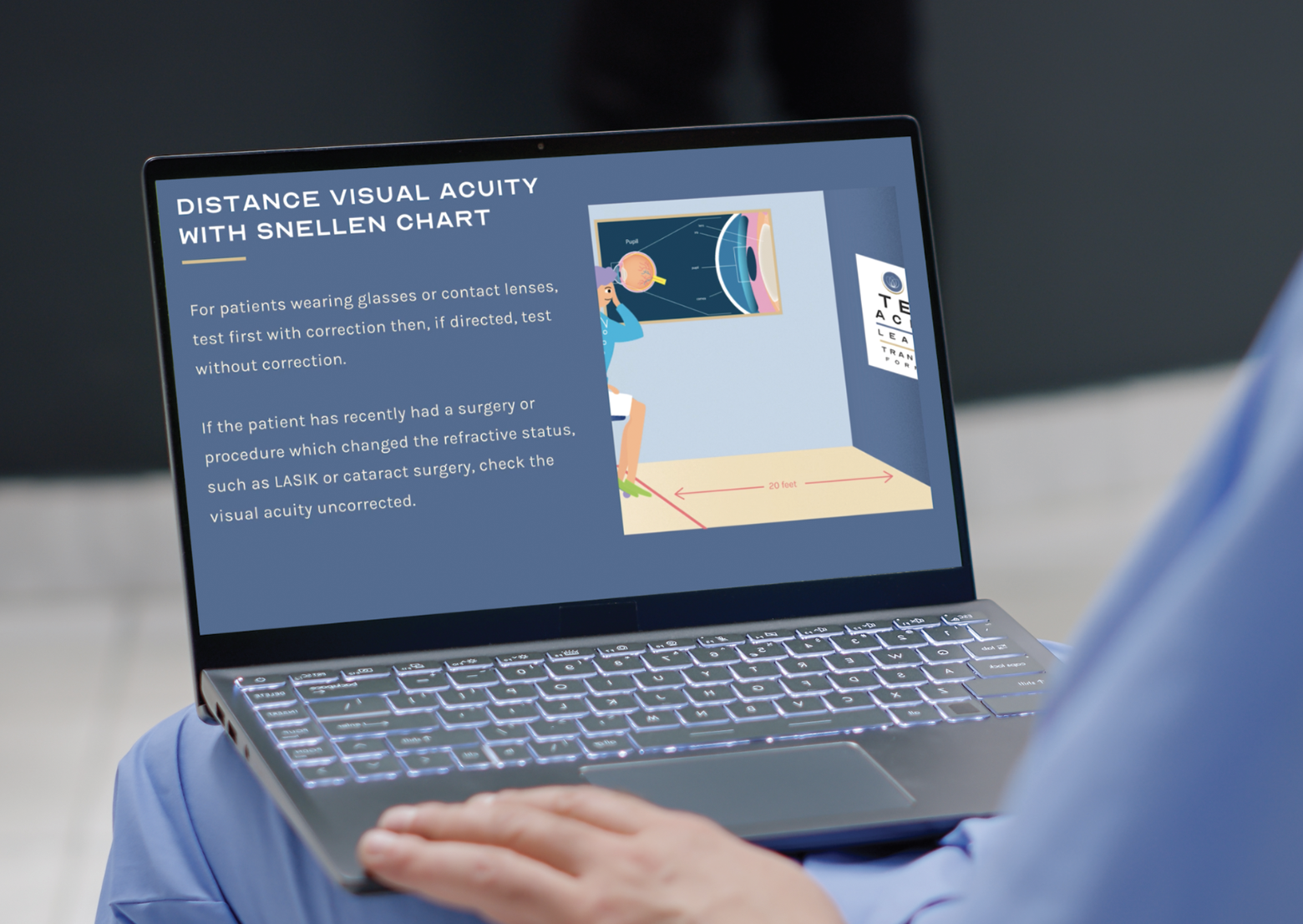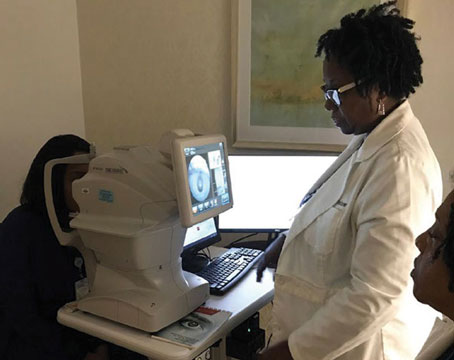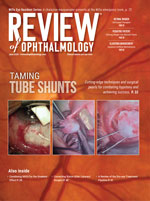 |
| Alchemy Vision offers over 100 videos and resources for training ophthalmic employees. Practices can manage the skills and techniques their staff members learn and set expectations for the new members being trained. (Courtesy Alchemy Vision) |
Artificial intelligence appears to be the future of many industries and disciplines. Naturally, many individuals are worried about the technology taking over their jobs, but AI, when used properly, has useful applications. For ophthalmology, research on AI technology has leaned more towards clinical applications, such as patient image analysis and diagnosis, but there’s more out there. Young physicians ready to start their own practices, as well as established physicians looking to change the way they do things, can implement this technology and other smart solutions to possibly improve their patients’ experiences, manage their staff better and even streamline medical coding.
Management Landscape
Anyone leading their own practice or managing a large clinic knows that it’s no easy task. John Berdahl, MD, an ophthalmologist at Vance Thompson Vision in Sioux Falls, South Dakota, shares his insight on the current landscape for leading and managing a practice. The issues he brings up may be able to be addressed by the application of new AI systems.
“Medicine is still fundamentally about meeting a person in their moment of vulnerability. It’s a people business,” says Dr. Berdahl. “You have to have the right people on your team, you have to meet patients where they’re at, and you have to be the right person to lead them.”
Figuring out how to manage and create the “right team” can depend on the size of the practice. Dr. Berdahl mentions how there’s business theory that can explain the limitations of managing a large-scale team. British anthropologist Robin Dunbar suggested that approximately 150 relationships is the cognitive limit for humans, also known as Dunbar’s Number,1 while other data suggests that when you break down relationships on an emotional level, then humans possess the cognitive capacity to maintain hundreds of relationships.1,2 However, not all practices’ teams are staffed with family members and/or best friends, so it can be difficult when leading a team of 100 or more members.
“Either you need to break into additional groups or put in a new layer of management,” proposes Dr. Berdahl. “You can see this in Amish culture, and you can also see it in some business structures. I know that Gore of GORE-Tex does this as well. The challenge with adding layers is that it can add bureaucracy, and it’s much harder to be a leader that’s in the middle, where you have to try to do the work for whoever your boss is and take care of the team below you. They don’t quite have the same perceived level of authority, usually, as the leader of the organization.
“I believe the key there is to make sure that the leaders you put in place are the type that can motivate their team,” continues Dr. Berdahl. “They know their team, and they’ve been enabled to make good decisions on behalf of the organization and take great care of their team.”
Now, it’s important to have a well-rounded team of surgeons, technicians and desk staff to ensure operations run smoothly, but some positions can be harder to fill than others. “I think that technicians are probably the hardest to find because they have a narrower skillset,” says Dr. Berdahl. “There’s a shortage of surgeons across the country, especially in certain subspecialties. Then, assistants and desk staff have a broader pool to draw from. But I think that one thing that practices lose sight of is that the biggest reason why somebody wants to work there is if it’s a great place to work, and that’s based on how people treat each other, and it starts at the top with surgeons.”
How can AI get more staff through the door?
TalentGPT with Beamery
Beamery is an online HR suite that allows leaders to hire, connect and manage their staff. This isn’t an ophthalmic-specific technology, but Beamery’s applications can assist physicians to find candidates that best match their work environment.
In 2023, Beamery announced in a press release that they’ve launched TalentGPT, a talent acquisition and talent management experience using generative AI. According to Beamery, users can generate new job descriptions that are focused on hiring based on the skills the user deems necessary for their work environment. For example, after HR has added each and every staff member and their skillsets to Beamery, then TalentGPT can assess what roles need to be filled and what skills need to be met. The AI program that allows this to happen is a combination of Beamery’s proprietary AI, OpenAI’s GPT-4 and other Large Language Models.
Another staffing feature that TalentGPT offers is a candidate pool based on the needs of the business. Once a job description is generated, TalentGPT will provide suggested candidates based on whether they meet the criteria needed or not. Each candidate is ranked by a five-star system, which depicts how well the candidate matches the job description. So, rather than assessing hundreds of candidates for a single position, HR can weed out certain candidates.
Training and Retaining
There are a number of training methods ophthalmologists can employ at their practice. One virtual tool that can enhance training without the need for AI is Alchemy Vision. On their website, they feature three subscription packages: Essential; Professional; and Premium. The Essential package offers more than 40 training videos covering essential skills for an ophthalmic practice and the program outlines the expectations for the position. Additionally, new staff members will be notified to stay on track with their course assignments during training.
The Professional package offers more than 100 training videos along with lectures and a library of study resources. One unique component offered is a badge system and leaderboard to engage the new staff members using a gamification method. This allows members to gain achievements as they move through the training process.
The Premium package includes all of the above, but it is more patient-oriented. This subscription tier pushes staff members to master Alchemy Vision’s Patient Centered Solutions model, which is meant to enhance the patient’s experience and increase practice revenue.
Communication with Patients
Phone COA and Lumata Health are two programs that can assist with patient communication. It’s important to inform patients as much as possible, whether it’s preoperatively or postoperatively. “We use technologies to help patients get just-in-time information via text message on what they’ll experience throughout their patient journey as a cataract, glaucoma, LASIK or other type of patient,” comments Dr. Berdahl.
• Phone COA. According to the company, Phone COA is a “virtual partner for ophthalmic practice management.” A team of virtual technicians reaches out to a practice’s patients and captures their information prior to their appointment. The information provided can help preload and prescreen charts and facilitate a seamless transition between EHR systems.
• Lumata Health. This program is on the postoperative end of ophthalmology. Similar to the idea Dr. Berdahl presented above, Lumata Health ensures patients with diabetic retinopathy, macular degeneration, glaucoma and other ocular pathologies are continuing their regimen, reminded about upcoming visits and are engaged between by contacting them via text or phone call. According to its website, Lumata Health can reduce the number of no-shows by 30 percent.
 |
| Nym medical coding requires zero human intervention. As illustrated above, physicians facilitate the first steps towards medical coding, completing a patient’s EMR. Then, when the physician is ready, they can streamline the coding process by sending the EMR to Nym’s coding software. Nym works with major EMR systems, but not all are systems are compatible. Nym is HIPAA-compliant. |
AI-Assisted Coding
Medical coding can be streamlined by hiring a medical coder to perform the task, but not everyone has the budget for another staff member. That’s where Nym comes in. Nym is an AI medical Coding Engine that assesses a patient’s EMR, codes the charts and sends the codes directly to billing. According to the company, Nym’s engine has maintained over 95 percent coding accuracy, but that’s not perfect. This is where AI technology needs to be monitored.
In a Nym blog post by Hudson Schertz interviewing Amy F. Ho, MD, the complexity of clinical language is addressed. One example provided in the post was on the use of the abbreviation “O.D.” For emergency medicine, this stands for “overdose,” but in ophthalmology, this means “oculus dexter.” While Nym can achieve 95 percent coding accuracy, these are the types of instances where manual monitoring is needed as the engine won’t be able to properly decipher the abbreviation unless it’s written out.
Future AI Programs
Modernizing Medicine creates specialty-specific EMR solutions for ophthalmologists. The technology they currently employ is intelligence amplification, which is similar to AI, but rather than completing the task, the program offers insight on the best ways to approach the task. Now, Modernizing Medicine is getting ready to implement their own AI technology in its software.
According to a March 2024 press release, Modernizing Medicine will be releasing an AI model to assist with documentation, patient collaboration and claims processing. AI-assisted documentation will assist ophthalmologists with detailed notes during patient visits. AI-assisted patient collaboration will use the technology to message patients in order to improve practice response times for a better patient experience, the company says. This would be a patient self-service where they can book or reschedule appointments, answer routine questions and manage bills without the need for constant phone communication between a practice and its patient. Finally, AI-assisted claims processing will help with flagging denials, which Modernizing Medicine believes will help reduce the burden on staff.
AI technology is incredibly useful, but experts say to be careful. “We do need to be sure that we’re using it properly, so we don’t just use AI to generate volumes of information that aren’t actually helpful for us,” says Dr. Berdahl. Hopefully, in the future, practices can become more streamlined with the help of AI-assistive technology.
Dr. Colvard is a surgeon at the Colvard-Kandavel Eye Center in Los Angeles and a clinical professor of ophthalmology at the Keck School of Medicine of the University of Southern California. Dr. Charles is the founder of the Charles Retina Institute in Germantown, Tennessee.
Dr. Berdahl has no financial interests to disclose.
1. Lindenfors P, Wartel A, Lind J. ‘Dunbar’s number’ deconstructed. Biol Lett 2021;17:5:20210158.
2. McCormick TH, Salganik MJ, Zheng T. How many people do you know?: Efficiently estimating personal network size. J Am Stat Assoc 2010;105:489:59-70.





